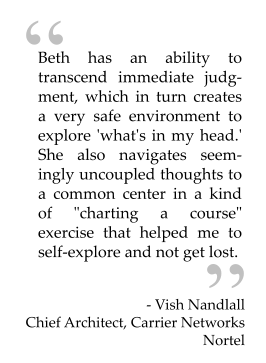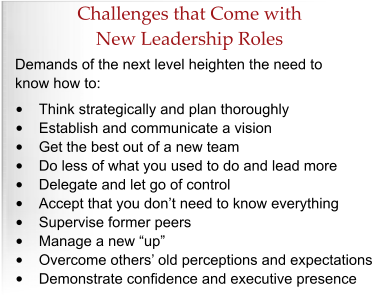Succession Plan Coaching

“Our succession plan looks great on paper, but we’ve had a few casualties, even with some top talent. What are we doing wrong?”
Keys to Success: Development and Support
A few great leaders are born that way. The rest, even those with loads of talent and promise, need some grooming and support to rise to their full leadership potential. People who will be successful at the next level are clear about what that looks like, and they know that’s where they want to be. They’re given opportunities to develop, and they take advantage of them. And they continue to be supported as they make the transition.
Why Succession Plans Fall Apart
 Putting together a good succession plan is painstaking work. But like any plan, if it’s not executed well, it’s not worth much. Too often, promising performers are expected to step into bigger roles and take off, like birds nudged out of the nest. But few leadership skills are part of the human DNA. Most have to be developed.
Putting together a good succession plan is painstaking work. But like any plan, if it’s not executed well, it’s not worth much. Too often, promising performers are expected to step into bigger roles and take off, like birds nudged out of the nest. But few leadership skills are part of the human DNA. Most have to be developed.
Leadership development is a shared responsibility. The organization has to provide the opportunities – coaching, mentoring, development programs, training, exposure, special projects, assignment rotations and more. Managers need to ensure leadership development goals are set and measured, help identify learning opportunities, and facilitate participation in them. Of course, all employees should take charge of their own growth, but high-potential leaders must be particularly proactive and diligent, putting learning and development efforts high on their priority list and sticking to their plan. Too often, people are rewarded solely for hitting business targets, so it’s no wonder that leadership development often sits on the back burner.
Once leaders are in a new role, things come at them fast, and it’s tough to stop, reflect and approach problems with a clear head. When the pressure’s on, people tend to rely on their strengths more than they should, and venturing outside their comfort zones can be terrifying. Add to that any one of the many stumbling blocks newly promoted leaders encounter, and it’s easy to see how things can go south in a hurry.
How Leadership Coaching Helps Make Succession Plans Work
 When coaching high-potential leaders at any level, whether “ready soon,” “ready now” or already in the role, I help them put together a targeted development plan. We base their goals on an understanding of the demands at the next leadership level, feedback from others, and their own assessments of their strengths and gaps. These become the agenda for coaching.
When coaching high-potential leaders at any level, whether “ready soon,” “ready now” or already in the role, I help them put together a targeted development plan. We base their goals on an understanding of the demands at the next leadership level, feedback from others, and their own assessments of their strengths and gaps. These become the agenda for coaching.
Once into the coaching process, we prioritize key stakeholder relationships and work on strategies for building them. We assess the intricacies of personalities and turf, and we plan ways of working within the culture without getting entangled in politics. We study their team for insight into each individual’s skills and needs and their ability to collaborate with each other.
Together we run through scenarios they’re likely to encounter, and consider different approaches to problem solving. As a real-world issue presents itself, I coach them to draw on their strengths and what they’ve learned to arrive at their own solution.
When I hear limited thinking, I challenge their perspectives. If I see them clinging to old habits, I call them on it. If I sense confidence waning, I help them remember their accomplishments and other assets so they can be at their best.
 No matter how positive and exciting, transitions can be a bumpy ride. For leaders on the fast track, a coach by their side can make the difference between failure and success.
No matter how positive and exciting, transitions can be a bumpy ride. For leaders on the fast track, a coach by their side can make the difference between failure and success.
Final Thoughts on Succession Planning
An organization that invests in leadership development gains more than the next generation of prepared leaders. When they can see a career path ahead of them, talented employees are much more likely to stick around and stay engaged and new talent is easier to attract. Only then is the ubiquitous platitude “our people are our number one priority” believable.
